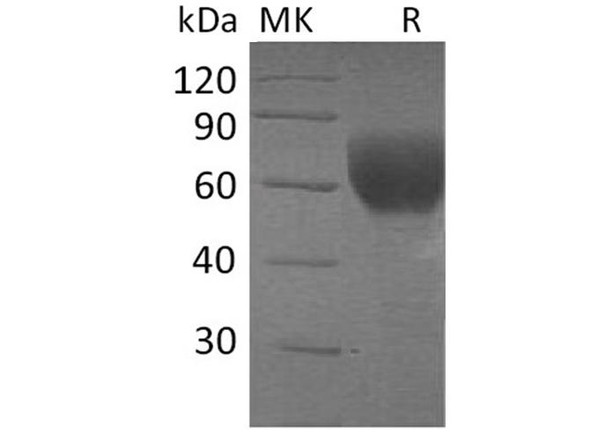Description
| Product Name: | Human TGFBR2 Recombinant Protein |
| Product Code: | RPPB2664 |
| Size: | 10µg |
| Species: | Human |
| Target: | TGFBR2 |
| Synonyms: | AAT3,FAA3, MFS2, RIIC, LDS1B, LDS2B, TAAD2, TGFR-2, TGFbeta-RII, TGFBR-2, TGF-betareceptor type-2, Transforming growth factor-beta receptor type II, TGF-betareceptor type II, TGF-beta type II receptor, TbetaR-II, TGFBR2. |
| Source: | Sf9 Insect cells |
| Physical Appearance: | Sterile Filtered colorless solution. |
| Formulation: | The TGFBR2 solution (0.5mg/ml) contains PhosphateBuffered Saline (pH 7.4) and 10% glycerol. |
| Stability: | Store at 4°C if entire vial will be used within 2-4 weeks. Store, frozen at -20°C for longer periods of time. For long term storage it is recommended to add a carrier protein (0.1% HSA or BSA). Avoid multiple freeze-thaw cycles. |
| Purity: | Greater than 95% as determined by SDS-PAGE. |
| Amino Acid Sequence: | TIPPHVQKSVNNDMIVTDNN GAVKFPQLCK FCDVRFSTCD NQKSCMSNCS ITSICEKPQE VCVAVWRKND ENITLETVCHDPKLPYHDFI LEDAASPKCI MKEKKKPGET FFMCSCSSDE CNDNIIFSEE YNTSNPDLLL VIFQLEPKSCDKTHTCPPCP APELLGGPSV FLFPPKPKDT LMISRTPEVT CVVVDVSHED PEVKFNWYVD GVEVHNAKTKPREEQYNSTY RVVSVLTVLH QDWLNGKEYK CKVSNKALPA PIEKTISKAK GQPREPQVYT LPPSRDELTKNQVSLTCLVK GFYPSDIAVE WESNGQPENN YKTTPPVLDS DGSFFLYSKL TVDKSRWQQG NVFSCSVMHEALHNHYTQKS LSLSPGKHHH HHH |
TGFBR2 is part of the Ser/Thr protein kinase family and the TGFB receptor subfamily. TGFBR2 is a transmembrane protein that has a protein kinase domain, forms a heterodimeric complex with another receptor protein, and binds TGF-beta. This receptor/ligand complex phosphorylates proteins, which then enter the nucleus and regulate the transcription of a subset of genes related to cell proliferation. Mutations in TGFBR2 gene have been associated with Marfan syndrome, Loeys-Deitz Aortic Aneurysm Syndrome, and the development of various types of tumors. TGFBR2 expression is increased in oral squamous cell carcinoma cells. TGFBR2 attenuates the biological activities of TGF-beta in colorectal cancer. TGFBR2 expression is decreased by IL-1beta while inducing Sp3 via NFkappaB. TGFB2 and TGFBR2 are involved in the antiestrogenic activity of tamoxifen metabolites in breast cancer.
TGFBR2 Human Recombinant produced in in Sf9 Baculoviruscells is a single, non-glycosylated polypeptide chain containing 383 aminoacids (23-166a.a) and having a molecular mass of 43.3kDa (Migrates at 40-57kDaon SDS-PAGE under reducing conditions).TGFBR2 is expressed with a 239aa hIgG-His tag atC-Terminus and purified by proprietary chromatographic techniques.
| UniProt Protein Function: | TGFBR2: a TKL kinase of the serine/threonine-protein kinase receptor (STKR) family. R1 and R2 TGF-beta receptors dimerize after binding TGF-beta at the cell surface. Binds to DAXX. Defects can cause esophageal cancer. |
| UniProt Protein Details: | Protein type:Oncoprotein; Membrane protein, integral; Protein kinase, TKL; EC 2.7.11.30; Protein kinase, Ser/Thr (receptor); Kinase, protein; TKL group; STKR family; Type2 subfamily Chromosomal Location of Human Ortholog: 3p22 Cellular Component: caveola; cytosol; external side of plasma membrane; integral to membrane; lipid raft; plasma membrane; receptor complex Molecular Function:ATP binding; glycosaminoglycan binding; metal ion binding; mitogen-activated protein kinase kinase kinase binding; protein binding; receptor signaling protein serine/threonine kinase activity; SMAD binding; transforming growth factor beta binding; transforming growth factor beta receptor activity; transforming growth factor beta receptor activity, type II; transmembrane receptor protein serine/threonine kinase activity Biological Process: activation of protein kinase activity; aging; apoptosis; blood vessel development; brain development; common-partner SMAD protein phosphorylation; embryo implantation; embryonic cranial skeleton morphogenesis; embryonic hemopoiesis; gastrulation; gut development; heart development; in utero embryonic development; lens development in camera-type eye; myeloid dendritic cell differentiation; negative regulation of cardiac muscle cell proliferation; negative regulation of transforming growth factor beta receptor signaling pathway; Notch signaling pathway; organ regeneration; palate development; patterning of blood vessels; peptidyl-serine phosphorylation; peptidyl-threonine phosphorylation; positive regulation of angiogenesis; positive regulation of B cell tolerance induction; positive regulation of cell proliferation; positive regulation of mesenchymal cell proliferation; positive regulation of NK T cell differentiation; positive regulation of skeletal muscle regeneration; positive regulation of smooth muscle cell proliferation; positive regulation of T cell tolerance induction; positive regulation of tolerance induction to self antigen; protein amino acid phosphorylation; receptor-mediated endocytosis; regulation of cell proliferation; regulation of gene expression; response to drug; response to estrogen stimulus; response to glucose stimulus; response to mechanical stimulus; response to nutrient; smoothened signaling pathway; transforming growth factor beta receptor signaling pathway; vasculogenesis; wound healing Disease: Colorectal Cancer, Hereditary Nonpolyposis, Type 6; Esophageal Cancer; Loeys-dietz Syndrome 2 |
| NCBI Summary: | This gene encodes a member of the Ser/Thr protein kinase family and the TGFB receptor subfamily. The encoded protein is a transmembrane protein that has a protein kinase domain, forms a heterodimeric complex with another receptor protein, and binds TGF-beta. This receptor/ligand complex phosphorylates proteins, which then enter the nucleus and regulate the transcription of a subset of genes related to cell proliferation. Mutations in this gene have been associated with Marfan Syndrome, Loeys-Deitz Aortic Aneurysm Syndrome, and the development of various types of tumors. Alternatively spliced transcript variants encoding different isoforms have been characterized. [provided by RefSeq, Jul 2008] |
| UniProt Code: | P37173 |
| NCBI GenInfo Identifier: | 116242818 |
| NCBI Gene ID: | 7048 |
| NCBI Accession: | P37173.2 |
| UniProt Secondary Accession: | P37173,Q15580, Q6DKT6, Q99474, B4DTV5, |
| UniProt Related Accession: | P37173 |
| Molecular Weight: | 67,457 Da |
| NCBI Full Name: | TGF-beta receptor type-2 |
| NCBI Synonym Full Names: | transforming growth factor beta receptor II |
| NCBI Official Symbol: | TGFBR2�� |
| NCBI Official Synonym Symbols: | AAT3; FAA3; LDS2; MFS2; RIIC; LDS1B; LDS2B; TAAD2; TGFR-2; TGFbeta-RII�� |
| NCBI Protein Information: | TGF-beta receptor type-2 |
| UniProt Protein Name: | TGF-beta receptor type-2 |
| UniProt Synonym Protein Names: | TGF-beta type II receptor; Transforming growth factor-beta receptor type II; TGF-beta receptor type II; TbetaR-II |
| Protein Family: | TGF-beta receptor |
| UniProt Gene Name: | TGFBR2�� |
| UniProt Entry Name: | TGFR2_HUMAN |







